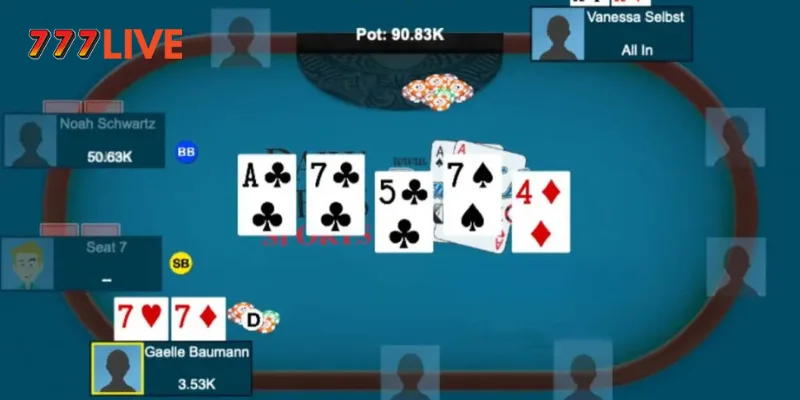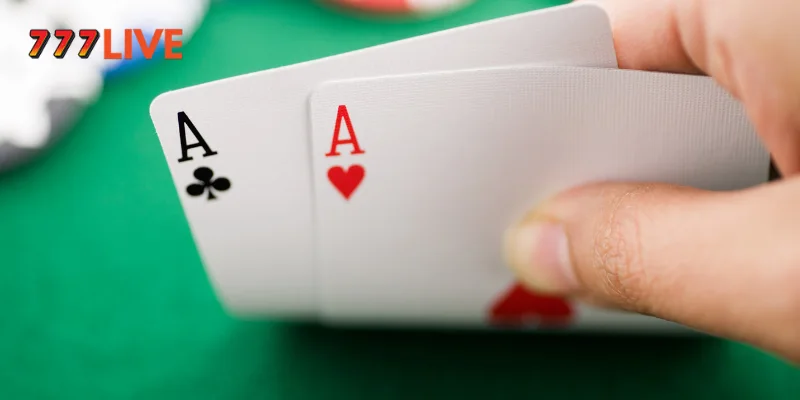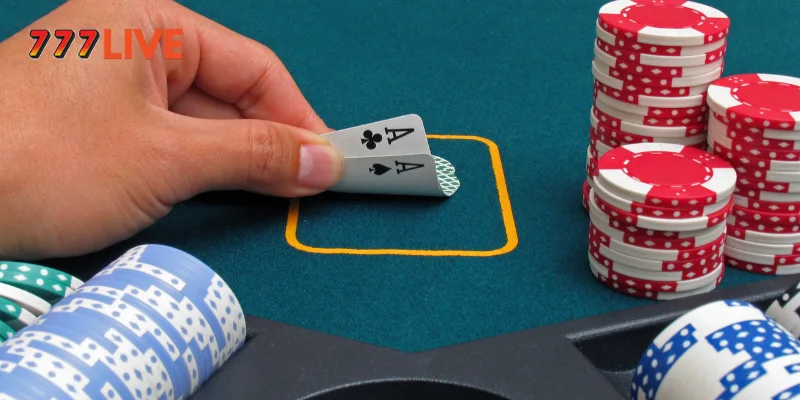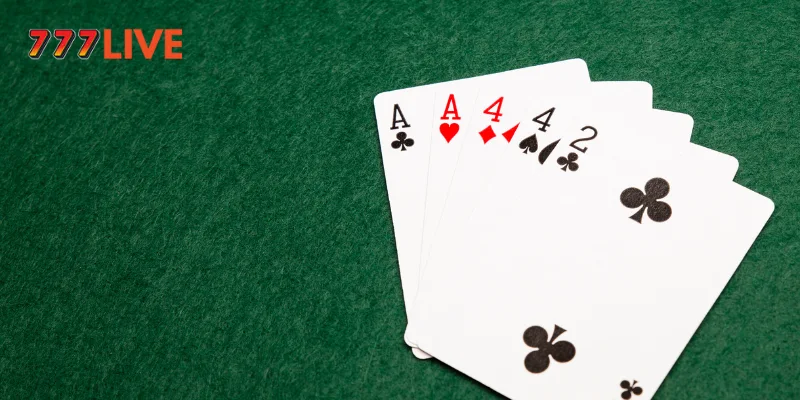When participating in Poker, you often receive starting hands that are small pocket pairs, typically ranging from 22 to 66. Faced with such hands, will you choose to fold or decide to call the bet in the initial betting round to see how things unfold? Let’s 777Live explore the approach to these small pairs in the following article.
Mastering how to handle small pocket pairs right from the initial betting round will significantly increase your win rate.
How to Approach Starting Hands That Are Small Pocket Pairs?
Let’s take a classic illustrative situation from the final round of an online Poker tournament: a player holding a pair of 7s won against an opponent holding the extremely strong Ace-Ace (AA).
In that hand, both players completed a Set (three-of-a-kind) right on the flop (the first three community cards). However, on the turn (the fourth community card), the player holding 77 was lucky enough to hit Four of a Kind (Quads), thus taking the lead and winning the hand outright.

According to statistical analysis, you can expect to receive these small pocket pair starting hands approximately once every 17 hands. And as mentioned, if not handled skillfully, these seemingly harmless hands can completely cost you all the chips in the pot.
The crucial factor determining success or failure when playing with small pocket pairs is your seating position at the table.
This means that with small pairs from 22 to 66, unfavorable positions at the table, usually from Under The Gun (UTG) to the middle positions, will make participating in the hand more risky.
You should learn more about the importance of different seating positions at a Poker table.
Should You Enter a Hand with a Small Pocket Pair as Your Starting Hand?
Many people wonder if they should fold immediately when receiving a small pocket pair. When playing online Poker with play money, it’s common to see many players decide to bet all their chips right in the initial betting round.
Of course, that’s play money, and losing it has no real consequences.
However, when playing real-money Poker, you need to reconsider this ‘shoving all-in’ approach right from the initial betting round.
Why Play with Small Pocket Pairs?
There are some positive outcomes to consider when your small pocket pair starting hand wins. These favorable possibilities include:
- How many players are participating in that hand?
- Is the pot odds (the ratio of potential profit to the cost of calling) attractive when calling in the initial betting round?
- Do you have enough chips to call in order to wait for a Set on the flop?
- Are you capable of playing passively (limping) if someone raises?

There is often a significant element of luck in these types of hands. The main issue is that all these favorable factors rarely align. To make a decision to participate with the risk involved for this type of hand, we should sometimes consider the following three factors:
- What is your position at the table when holding a small pair?
- What is your opponent’s playing style? (Tight, loose, passive, or aggressive?)
- How many chips do you have compared to the blinds?
Entering a hand with a small pocket pair as your starting hand is a long-standing tactic in Texas Hold’em Poker. You need to evaluate the three criteria mentioned above before further considering your specific position at the table when holding a small pair.
If you don’t complete a Set right on the flop, continuing the hand often leads to losing money. If you don’t get a Set on the flop, in most cases, it’s best to fold. However, you can choose not to bet (check) to see how your opponents act.
Remember that if you are only hoping to complete a Set on the turn and river when the community cards on the flop are higher than your small pair, that is truly “burning money.” The most important goal when playing Poker is the total amount of money you win after a whole day of playing, not just the result of winning or losing on a single hand.
This “calling station” style of play is only for those who do not yet understand strategy.
You can refer to how to play Poker in the initial betting round based on your seating position.
What is Your Opponent’s Playing Style?
Who are the opponents participating in the hand with your small pair? What is their playing style?
There are four typical types of Poker players:
- Plays very tight (participates in few hands).
- Has a somewhat loose playing style (likes to play many hands).
- Plays passively (rarely bets or raises).
- And frequently bets or raises (aggressive).
Learn about the four types of Poker players you need to identify.
You can absolutely call to see the flop when holding a small pocket pair if:
- Your opponent is a weak player, has a passive playing style, and rarely re-raises in the initial betting round.
- And you are in a favorable position to act after a passively playing opponent (e.g., the opponent limps, and you are immediately after or in the late positions).
This gives you excellent pot odds.
It’s easy to spot the playing style of those at the table. As mentioned, there are many weak and passive players out there, especially at online casinos. Therefore, focus on observing your opponents’ playing styles when you participate in a hand.
With tables that have many such opponents, it’s truly a great environment for you to implement the playing strategy outlined above.
Should You Wait to Complete a Set on the Flop When Holding a Small Pair?
Why do people often call to see the flop and wait to complete a Set right there when holding a small pair? With the strategy of waiting for a Set, remember one number: the odds of completing a Set right on the flop are approximately 10-12%.
Thus, the amount you are willing to call should be at least 10 times the amount you put in to call. If you call $10 for a chance to win $100 when you complete a Set (with a 10% chance), you are only breaking even theoretically. Meanwhile, there is no guarantee that when you complete a Set, you will win the full $100:
- Opponents may have a stronger hand (a higher-value Set, a Straight, a Flush…).
- Opponents may have a weak hand and fold when raised (holding QQ when the flop has an Ace, holding AK with no pairing, holding trash and bluff-raising…).
- Players may use a pot control strategy and only lose a small amount of money, not their entire stack on the table.
To be more certain, ideally, the amount of chips you have left behind should be 15-20 times the opponent’s bet before you call.
You should fold a small pocket pair starting hand in the initial betting round if:
- Sitting in an early position with a remaining stack of about 20-30 big blinds, you should fold.
- Facing a large 3-bet (third raise), you should fold.
- Having a remaining stack of about 20-30 big blinds and a tight player has already raised before you, you should fold.
Should You Go All-In in the Initial Betting Round with a Small Pocket Pair as Your Starting Hand?

If the amount of money in the pot is already large enough and your opponents are highly likely to fold when you go All-in, then you will win the money in the pot without having to show your cards.
Situations where you can go All-in when holding a small pocket pair starting hand:
- No one has entered the pot yet, and you go All-in with 10-15 big blinds.
- A loose player raises, and you go All-in with 15-20 big blinds.
- A loose player raises, another loose player calls, and you go All-in with 20-25 big blinds.
- A player who often re-raises after being 3-bet by you, and your All-in stack is about 5 times their 3-bet amount.
- You 3-bet, your opponent 4-bets, and you 5-bet All-in with a stack about 4-5 times their 4-bet amount.
Why do we go All-in with small pocket pairs like this?
Because small pocket pair starting hands maintain a fairly good potential win rate (equity) (always around 33% even if the opponent’s potential hand range is very strong, unlike some other types of hands that lose equity very quickly).
You can also refer to experience playing small pocket pairs here.
Summary
Thus, if you are holding a small pocket pair starting hand, consider the following factors to make your playing decision:
- Is your position at the table favorable for calling?
- Is your opponent playing loose, passive, and rarely re-raising before the flop?
- Is your current chip stack reasonable for you to call to see the flop and wait to complete a Set?
- Is the amount of money in the pot already large enough that you can go All-in with your entire stack to steal the pot?
In addition, there are some other approaches to small pocket pair starting hands, such as calling and using your position to steal the pot on the flop. This playing style requires experience and relies on the community cards that have been revealed.
At the same time, you should observe your opponents’ playing styles, calculate the probability of future cards… If you are inexperienced, you should not try these methods.
Practice your Poker skills well before trying such risky strategies.
Many people are also overly confident in their ability to dominate opponents with their skills. They forget that when their chip stack gets low, the power of position, experience, and playing technique are no longer as important as the strength of the hand their opponent is holding.
Do you have any other ideas for playing small pocket pairs? Share your real-money poker playing experiences below!


